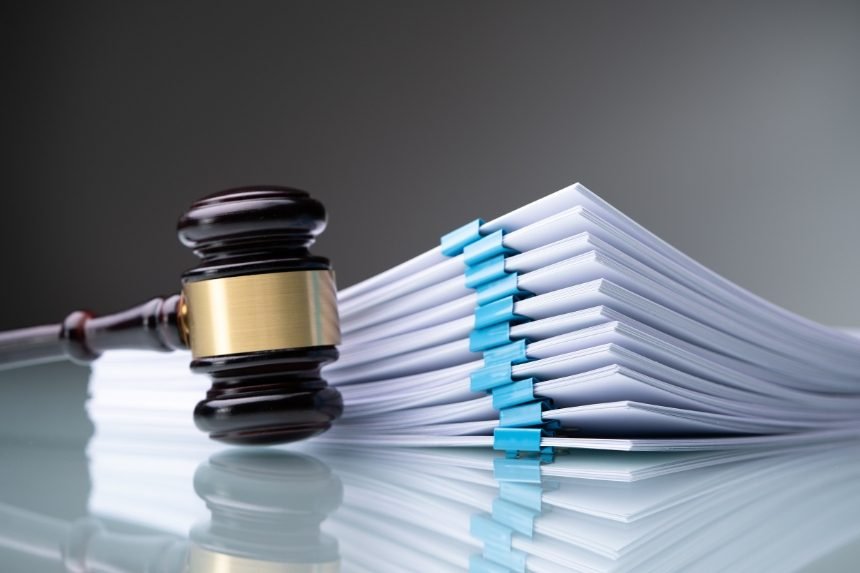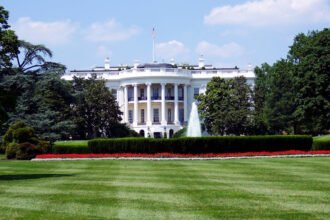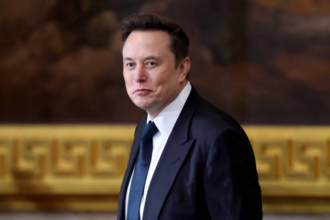The debate over Trump tariffs has evolved beyond a policy dispute into a constitutional test with stakes that stretch across global markets and domestic governance. What began as a forceful economic strategy designed to shift trade advantages in favor of the United States has evolved into a defining confrontation between presidential authority and congressional oversight. The Supreme Court’s review is poised to determine whether emergency powers can justify sweeping tax changes, or if traditional legislative control over trade and taxation must remain intact.
- How Tariffs Became a Central Tool of Executive Power
- Terry Precision Cycling and the Small-Business Stand
- Supreme Court to Decide the Limits of Executive Trade Power
- The Court of International Trade and the Path to the Supreme Court
- Global Reaction and Diplomatic Realignment
- Domestic Economic Impact
- Futures to Constitutional and Economic Future
- Conclusion: An American Government Chapter
- FAQs
This case holds weight not just in trade circles but in the very structure of American democracy. It asks whether a president can reshape economic relationships through executive declarations alone or whether such decisions must come from Congress, as outlined in the Constitution. Economists, constitutional scholars, and world leaders are watching to see if this ruling will limit or expand presidential power for decades.
How Tariffs Became a Central Tool of Executive Power
Emergency Authority and a New Economic Approach
When former President Donald Trump invoked national emergency powers to justify broad import taxes, he used a legal framework historically reserved for freezing assets or blocking transactions connected to hostile foreign threats, espionage, terrorism, or security breaches. Instead, he applied the International Emergency Economic Powers Act to global commerce. This move marked a seismic shift in how emergency authority could be interpreted.
Rather than addressing isolated national security risks, the administration argued that long-standing foreign trade practices constituted an “extraordinary threat.” Supporters say this approach was long overdue and necessary to confront unfair economic behavior. Critics counter that this interpretation stretches the law beyond recognition and undermines the separation of powers.
The Birth of a New Trade Doctrine
On what the administration called “Liberation Day,” tariffs were announced across nearly all global imports. Countries like Brazil, India, China, Mexico, and Canada faced sharp spikes in import costs. Supporters claimed that the move protected American workers and revived domestic manufacturing. Opponents warned that transforming tariffs into emergency-driven tools destabilized global supply chains and politicized trade systems that historically relied on cooperation and predictability.
Rather than a surgical tool, tariffs became a multipurpose diplomatic weapon. They were deployed not only in trade disputes but in negotiations concerning immigration, drug trafficking, and foreign political controversies. Nations learned that economic access to the U.S. market could hinge on a diverse set of White House priorities.
Terry Precision Cycling and the Small-Business Stand
Why One Company Took the Fight to the Top Court
Amid this policy storm, Terry Precision Cycling emerged as one of the most visible challengers. The company, dependent on imported bicycle components, faced steep cost increases. Large corporations had the resources to shift suppliers or distribute added costs. Smaller companies like Terry Precision Cycling did not.
Their lawsuit argues that executive economic authority cannot override Congress’s constitutionally mandated responsibility to regulate trade. Their stance is not just about financial hardship; it is about governmental structure. In their view, if one president can impose tariffs under vague emergency claims, future presidents could weaponize economic power in unpredictable ways. Visit our homepage for more information.
A Voice for Small American Manufacturers
While some business groups quietly supported the administration, others feared the long-term precedent. Terry Precision Cycling’s legal effort represents thousands of smaller enterprises caught between foreign suppliers and domestic consumers. Their challenge reached the nation’s highest court not because they wanted confrontation, but because they felt the future of fair and stable commerce depended on judicial clarification.
Supreme Court to Decide the Limits of Executive Trade Power
The Central Constitutional Question
The Supreme Court will hear arguments addressing whether emergency powers allow a president to impose widespread economic penalties without Congressional consent. While lower courts ruled that the IEEPA does not authorize tariff creation, the case now rests with the highest court to determine constitutional interpretation.
Some justices may focus narrowly on statutory language: the law does not explicitly authorize new import duties. Others may view this through the broader lens of national security, granting deference to the executive branch. How the Court frames its questions could signal whether it leans toward restraint or expansion of presidential authority.
The Political and Economic Stakes
If the Court upholds the administration’s actions, future presidents—regardless of party—could use emergency powers to alter global trade instantly. If it overturns the policy, Congress will reclaim exclusive tariff authority, reinforcing its constitutional role. Either way, markets, allies, and adversaries must prepare for lasting consequences.
The Court of International Trade and the Path to the Supreme Court
Lower-Court Decisions
The Court of International Trade issued rulings rejecting the administration’s interpretation of emergency authority. Those rulings held that the president exceeded legal boundaries. Yet the duties remained temporarily in effect during appeals, raising uncertainty for businesses navigating supply chains and pricing structures.
The court of international trade tariffs ruling affirmed Congress’s central role in tax and duty decisions. Still, the White House continued to defend its approach, arguing that global competition and national security now require agile executive intervention.
Appeals and Continued Enforcement
During the appeals process, emergency-based import taxes were not immediately lifted, effectively reinstating Trump tariffs pending Supreme Court review. Some analysts predict the Supreme Court may not only rule on legality, but also clarify the limits of emergency-based economic authority more broadly.
Global Reaction and Diplomatic Realignment
Foreign Governments Respond
International allies and rivals reacted swiftly. Some negotiated concessions. Others imposed retaliatory duties. Nations like China and EU members explored deeper economic cooperation, partly to hedge against unpredictable U.S. trade actions. Global markets grew more cautious, and supply chain adjustments accelerated.
Geopolitical Shifts
Foreign leaders learned that trade access to the American market could hinge not just on commerce but on political alignment with Washington. In some cases, foreign governments restructured economic policy to avoid confrontation. In others, they adopted counter-measures, strengthening ties with alternate trade partners. These shifts illustrate that tariff policy can reshape global influence.
Tiger Woods Confirms Relationship with Vanessa Trump
Domestic Economic Impact
Consumers, Manufacturers, and Inflation Dynamics
Critics argue that consumers eventually suffer the cost of tariffs in the form of increased prices. Those in favor claim that the obligations supported priorities on a national scale and recovered industries that were decimated by international competition. Both results were achieved to some extent.
Competitive safeguards came to the rescue of certain industries. Others had a hard time with high material prices. Big importers hoarded merchandise as they awaited an increase in tariffs, and small businesses were often unable to pursue such a course. The resultant turmoil in the marketplace led to fluctuations in pricing and friction in the supply chain.
Organizational Supply Chain Variations
Either as a safeguarding or as a disruptive, the emergency-related importation taxes compelled companies to re-examine sourcing on a global basis. Firms concentrated on manufacturing investments in Mexico, Southeast Asia, and portions of the U.S. in an effort to avoid tariffs. Uncertainty in businesses was incorporated in the strategic planning, and the role of trade-policy uncertainty was oversized.
Futures to Constitutional and Economic Future
In case the Policy is upheld by the Supreme Court’s unanimous decision ionTrump tariffs will transform executive trade powers over the centuries. Presidents were able to levy tasks very quickly, react to external activities on the spot, and use market accessibility in diplomatic talks. This kind of power would essentially change the way America was governed, with economic power being concentrated in the Oval Office.
In case the Court Disapproves of the Approach
In case the Court strikes down the tariff model, which is based on emergency, trade powers will be regained by Congress. Tariffs will not be eliminated, but rather done via a codified process. The trade decisions would become more predictable and slower. A more lucid legal system can bring business investment and international relations to a more stable state.
Conclusion: An American Government Chapter
One Such Decision That Crosses Trade
The struggle with Trump tariffs is the new point in American legislation and the international economy. It challenges the ability of one arm of government to redefine international trade by drawing on states of emergency or states of the balance of power in the constitution. The case will affect not just the economic course of the United States but the institutional framework of the presidential authority itself.
A Nation and World Await
The decision of the Supreme Court will be an indication of how the United States will rule in an interconnected and intricate world. Whether the policy is limited or supported, this case will be recorded in history as one of the landmarks in terms of constitutional limits and leadership of trade. The dinner table is waiting to see how their country will utilize its economic power in the coming year, and businesses, foreign governments, and American citizens are waiting to find this out as the justices debate.
Supreme Court to review Trump tariffs in globally watched case
FAQs
1. What are the Trump tariffs?
They are import taxes imposed by former President Trump to pressure other countries, reduce trade deficits, and boost U.S. manufacturing. They were used as an economic and foreign-policy tool.
2. Why is the Supreme Court reviewing Trump tariffs?
The Court is deciding whether Trump legally used emergency powers under IEEPA to impose broad tariffs without Congress. The case questions presidential power limits.
3. Can the Supreme Court strike down these tariffs?
Yes, the Court could block the emergency tariffs if it finds they exceed presidential authority. It could also allow them to expand executive power.
4. What does Congress have to do with tariffs?
The Constitution gives Congress authority over taxes and import duties. This case tests whether a president can bypass Congress using emergency powers.
5. What happens if Trump tariffs are overturned?
Some tariffs may be removed, and future presidents may face limits on emergency trade actions. Businesses and global markets could see short-term adjustments.
6. How will small businesses be affected?
Import-dependent small firms say sudden emergency tariffs raised costs and created uncertainty. The ruling could determine how protected they are from such shocks.
7. Are these tariffs still active?
Many are still in place while the Court decides. Some were adjusted or paused, but key emergency tariffs remain pending the decision.
8. Could future presidents copy this strategy?
If upheld, future presidents could use emergency powers to impose wide trade duties quickly. If rejected, they’ll need Congress or a slower legal process.








